|
|
|
Sort Order |
|
|
|
Items / Page
|
|
|
|
|
|
|
| Srl | Item |
| 1 |
ID:
135081


|
|
|
|
|
| Summary/Abstract |
This article examines the activities of the Islamic Development Bank in Azerbaijan, Kazakhstan and the four other Muslim majority states of southern Eurasia, where the institution has been active, in a rather discreet but targeted way, in the fields of transport, energy and water infrastructure, finance and industrial development since about one and a half decades. Besides offering an analytical overview of the regional activities of this rather little known development institution, it discusses how it is de facto a channel and way-opener for investment form the Arab and more particularly the Arab Gulf sphere, and how its presence fits into a trend among southern Eurasian governments and economic elites to diversify sources of aid and investment.
|
|
|
|
|
|
|
|
|
|
|
|
|
|
|
|
| 2 |
ID:
135710
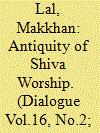

|
|
|
|
|
| Summary/Abstract |
India and China are not only the two oldest living civilizations in the world but still remain attached to their roots. Both the civilizations have seen, in the various stages of their existence, seven other Great Civilizations – Roman, Greek, Egyptian, Mesopotamian, Inca, Aztec and Maya – disappearing from the face of earth. By this simple fact one can understand the stability and all encompassing nature of both the civilizations – India and China. While the Chinese civilization continues from 1300 B.C. till date; the Indian civilization has continued with its ups and downs from 7th millennium B.C. – a time span of almost 9,000 years. Excavation of an Upper Palaeolithic shrine at the prehistoric site at Baghor, near Allahabad, and the similar shrine being in use today in the nearby village (see figs.1A and 1B) shows how the continuity, even in the shape of an abstract deity and the structure of shrine can survive almost over millennia.
|
|
|
|
|
|
|
|
|
|
|
|
|
|
|
|
| 3 |
ID:
135836


|
|
|
|
|
| Summary/Abstract |
In 2003, I published Shivaji: Hindu King in Islamic India, a book in which I reflected upon what I termed ‘unthinkable thoughts’. Such thoughts would be interpretive historical hypotheses that are so alien to popular cultural values that they become inconceivable, even when the evidence might point in their direction. In my case, once I expressed such thoughts, they produced not only a new eruption of defensive mechanisms to shore up the reputation of a venerated hero and all those values he symbolises, but also destabilised an historical discourse that had its own internal divisions. In Maharashtra, a small group of activists reacted to the unthinkable thoughts in my book and called for its ban, and the denunciation of that book became a hot button issue during India's national elections of 2004.
|
|
|
|
|
|
|
|
|
|
|
|
|
|
|
|
| 4 |
ID:
137177
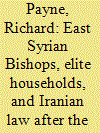

|
|
|
|
|
| Summary/Abstract |
This article is an exploration of the interconnected legal ties between Christians and Zoroastrians in the early Islamic era. Drawing from the writings of the Christian authors Ishobokt, Simeon, and Henanisho, Payne describes how East Syrian bishops appropriated laws of marriage, inheritance, and property from Iranian jurisprudential traditions as a means of transferring wealth intergenerationally and extending their judicial authority. Payne thus explores the ways in which the Christians of Iran were influenced by the Iranian legal system and culture and in the seventh century CE.
|
|
|
|
|
|
|
|
|
|
|
|
|
|
|
|
| 5 |
ID:
137178
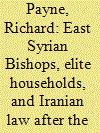

|
|
|
|
|
| Summary/Abstract |
This article is an exploration of the interconnected legal ties between Christians and Zoroastrians in the early Islamic era. Drawing from the writings of the Christian authors Ishobokt, Simeon, and Henanisho, Payne describes how East Syrian bishops appropriated laws of marriage, inheritance, and property from Iranian jurisprudential traditions as a means of transferring wealth intergenerationally and extending their judicial authority. Payne thus explores the ways in which the Christians of Iran were influenced by the Iranian legal system and culture and in the seventh century CE.
|
|
|
|
|
|
|
|
|
|
|
|
|
|
|
|
| 6 |
ID:
136576


|
|
|
|
|
| Summary/Abstract |
The Moluccas were among the provinces devastated by communal conflict following the fall of the New Order regime in 1998. Peace-building activities were conducted after the violence subsided. The field research for this ethnographic study was conducted in the province from January to December 2009. The objective of the study was to examine the nature and impact of peace education projects supported by foreign agencies in selected schools in the province. The findings show that suspicion and hatred between Muslim and Christian students remained intact in Schools 1, 2 and 3, despite the fact that they received a peace education intervention. In these schools, the peace education projects were framed within what was perceived as Moluccan local tradition. However, School 4 was able to mitigate the effects of the conflict and to nurture peace in the school, despite the fact that it did not receive a specifically tailored peace education intervention. Students of School 4 showed a strong preference for national identity, which encompasses religious and ethnic boundaries. The study indicates that identity politics were at play in the form of the inclusion of what was perceived as Moluccan local tradition but the exclusion of other possibilities in the peace education curriculum, as the cases of Schools 1, 2 and 3 show. The study also shows that school principal leadership was prominent in helping to create a peaceful atmosphere, as the case of School 4 reveals.
|
|
|
|
|
|
|
|
|
|
|
|
|
|
|
|
| 7 |
ID:
136573
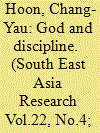

|
|
|
|
|
| Summary/Abstract |
A school is an institution in which student subjectivity is constituted and reinscribed through various 'disciplinary technologies'. The interplay between discipline and discipleship in the practice of Christian education is mutually constitutive. Through the study of a Protestant Christian school in Jakarta, this article explains the disciplinary technologies deployed by the school in its inculcation of discipline and character building. By examining the school's religious education practices the study provides insight into the perceptions of the school management, teachers and students with regard to various ethical, moral and religious issues. The author considers how Christian schools can develop critical reflective skills and respect for differences, and so can contribute to a tolerant, peaceful and multicultural Indonesia.
|
|
|
|
|
|
|
|
|
|
|
|
|
|
|
|
| 8 |
ID:
135837


|
|
|
|
|
| Summary/Abstract |
It is rare indeed that ancient Indian history makes the news, but this is precisely what happened in February 2014. From The New York Times to The Guardian, from The Times of India to The Australian, media outlets all around the world reported that Wendy Doniger's book, The Hindus: An Alternative History, had been withdrawn from sale in India. The publisher, Penguin Books India, pulled the 800-page tome from the shelves in response to legal action brought by a conservative Hindu activist, Dinanath Batra. Four months later, a second book by Doniger, On Hinduism, also fell victim to India's citizen censors.
|
|
|
|
|
|
|
|
|
|
|
|
|
|
|
|
| 9 |
ID:
136118


|
|
|
|
|
| Summary/Abstract |
This article explores the ways in which “Englishness” is constructed in relation to the siting of mosques, using Cambridge as a case study. After engaging with contemporary debates on Englishness and multiculturalism, the authors examine the responses to a planning application to build a mosque in the Mill Road area of the city. In public responses to the proposal, discourses of culture and heritage feature strongly. This contrasts with the ostensibly neutral language of the official planning procedure. Cultural ideas about “Englishness” are present on all sides of the debate and are not easily classified as nationalist or reactionary.
|
|
|
|
|
|
|
|
|
|
|
|
|
|
|
|
| 10 |
ID:
135717


|
|
|
|
|
| Summary/Abstract |
The Asiatic cultural continuum, with India at the centre of the gravity, is a fact yet to be discovered and discoursed fully. There has been multi-directional diffusion of the cultural traits and the belief systems. Some religious and socio-cultural traits, such as ancestor worships, belief in life after death, rebirth, re-incarnation, Karmic theory and
liberation from the life-cycle (nirvāna and moksa), used to be widespread covering entire Asia. The commonality extended in many other aspects linked to the traditional religions, what we call Sanatan Dharma, presently called Hinduism. The discovery of the commonality helps self-discovery and self-appraisal; it becomes an act of selfportraiture. Of course, in India, information on such topics is never given to the students, it is taboo practiced by our academics and intellectuals to have discourse on such subjects. This leads to ‘Culture/ tradition illiteracy’, a dominant trait of English educated modern Indians. As a result, our elite have inherited lot of myths, lies and
confusion from their colonial masters. Anything beyond political India, even if non-political and otherwise deeply linked, is alien for them. The denial syndrome is pervasive; it envelopes cultural, linguistic, historical and all other spheres. There is an increasing trend of replacing India for ‘South Asia’ during the academic discourses today; the use of the term ‘Bharata’ is becoming rarer in scholarly writings,
which is part of the same malady.
|
|
|
|
|
|
|
|
|
|
|
|
|
|
|
|
| 11 |
ID:
134478


|
|
|
|
|
| Summary/Abstract |
Islamist extremism through al-Shabaab is increasing its foothold in Kenya. In contrast to the common perception—as depicted through government responses—radicalization and recruitment extends well beyond Somali and Kenyan–Somali nationals. Instead of exclusively focusing on external or environmental factors, the study on which this article is based analyzed the personal background of those being radicalized. This article will focus on the role the family and peers play in the political socialization process while analyzing factors influencing radicalization, most notably religious identity, economic, political, and educational background of al-Shabaab members. Based on interviews with al-Shabaab and family members the last part of the article evaluates when, why, and how respondents joined al-Shabaab. Through answering these key questions the Kenyan government and other agencies assisting in preventing radicalization can develop more effective counterradicalization and counterterrorism strategies based on empirical evidence
|
|
|
|
|
|
|
|
|
|
|
|
|
|
|
|
| 12 |
ID:
135718


|
|
|
|
|
| Summary/Abstract |
Lord Shiva is alive and well in Thailand, but few if any know where he is. But with a little curiosity and the willingness to explore his whereabouts the results will reveal a surprising amount of presence of Lord Shiva in Thailand. Of the twelve royal festivals that still take place under the guidance of the Phra Maha Rajaguru Bidhi Sri Visudhigun, head Brahman priest to the royal family, Lord Shiva is not only recognized but is invited to stay in Thailand for ten days during the Giant Swing ceremony, which takes place in January of every year.
|
|
|
|
|
|
|
|
|
|
|
|
|
|
|
|
| 13 |
ID:
134636
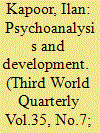

|
|
|
|
|
| Summary/Abstract |
International development has tended to ignore – or, tellingly, repress – human/social passions. Yet the theory and practice of development is replete with disavowed memories (racism, (neo)colonialism, gender discrimination) and traumatic prohibitions (economic recession, poverty), which show up in dreams and fantasies (the exoticised Third World, structural adjustment as universal panacea), obsessions (economic growth, ‘wars’ against poverty or terror), or stereotypes (denigration, infantilisation, sexualisation or feminisation of the Third World Other). Psychoanalysis aims precisely at helping tease out these passions, that is, the unconscious fantasies and desires embedded in development. It helps explain the gap between development’s scientific commitments (eg belief in progress, neutrality, objectivity, rationality) and its irrational practices (eg the seductive draw of narrow capitalistic growth, the fatal pull to aggressive racism, or the blind conformity to bureaucratic procedures or ethnic/religious identities). It helps us understand that development is not only a socioeconomic construction, but also an ideological construction intent on effacing its various internal traumas and contradictions – for example, the way in which development is “naturally” equated with neoliberal growth and liberal democracy, concealing the reality of rapacious capitalism, growing global inequalities and unevenness, and diminishing avenues for political contestation. The five articles in this sub-theme for Third World Quarterly aim to examine the intersection of psychoanalysis and development, applying in particular (although not exclusively), a Lacanian/Žižekian lens to a range of development issues.
|
|
|
|
|
|
|
|
|
|
|
|
|
|
|
|
| 14 |
ID:
135716
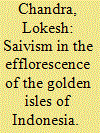

|
|
|
|
|
| Summary/Abstract |
The seventy-five glorious years of the Bharatiya Vidya Bhavan have been the heaven and jasmine of its founder and his clarion call of Jaya Somanatha, to bloom the cultural dreams of a renascent India, to unveil the shining peaks of our minds over the millenia. The noble vision of Kulapati Munshi became embedded in the Bhavan to keep alive the light on the horizons of history, and angelic in the wrappings of life: can flowers forget the spring? It is in tune with the founding spirit of the Bhavan to celebrate its platinum jubilee with a symposium on Abhinavagupta the great master of the Trika philosophy of Kashmir, who also formulated a new theory of aesthetics. A few weeks before Kulapati Munshi ascended the Heavenly Fields of eternal Vrindavana beyond the plane of duality, I was in Mumbai and went to see him. He lay on his couch, with his charming consort Leelavati sitting beside him. I began with an interpretation of his historic noval Jaya Somanatha. Somnatha was a temple dedicated to Lord Śiva as the Lord of the Moon, as the guardian of trans-oceanic merchants. The waxing and waning of the Moon has fatal effects on the waves of the oceans which toss the ships in deadly turbulence. The Jātakamālā of Āryaśūra recounts the voyage of the seasoned steersman Supāraga when the sea took a terrible aspect all of a sudden: like the earth quivering with her mountains at the time of world destruction. The sea rose up in rage, saddening the hearts of the occupants Supāraga refers to Sopara seaport in Gujarat. Just as Śiva lessened the impact of the torrents of the Gangā descending to earth, so does' He mitigate the tumult and turbulence, the Sturm und Drang, caused by the Moon (Soma). As Lord of the Moon, as Soma-nātha, he blesses marine travel with safety and assurance. Somnath was a Temple of Mariners, and even Arab merchants made offerings for safety and success in their trade. The renown of the extravagant riches of Somnath spread all over the lands of trans-national trade, whether Alexandria, Iraq, Iran or Central Asian kingdoms. Its immense oppulence attracted greed and fundamentalism in 1024AC when it was sacked after a fiercely contested battle in which fifty thousand defenders were killed and the invaders returned with a huge booty.
|
|
|
|
|
|
|
|
|
|
|
|
|
|
|
|
| 15 |
ID:
137181


|
|
|
|
|
| Summary/Abstract |
This article proposes a new approach to three of the most persistent problems in the study of Iranian art and religion from the coming of Alexander to the fall of the Sasanians: the development of Iranian sacred architecture, the legacy of the Achaemenids, and the development of the art and ritual of Iranian kingship after Alexander. Canepa explores the ways in which the Seleukids contributed basic and enduring elements of Iranian religious and royal culture that lasted throughout late antiquity. Beyond stressing simple continuities or breaks with the Babylonian, Achaemenid or Macedonian traditions, this article argues that the Seleukids selectively integrated a variety of cultural, architectural and religious traditions to forge what became the architectural vocabularies and religious expressions of the Middle Iranian era.
|
|
|
|
|
|
|
|
|
|
|
|
|
|
|
|
| 16 |
ID:
135719


|
|
|
|
|
| Summary/Abstract |
Although, ancient Cham sculptures underwent transformation under the influence of Brahmanism was presented under certain common rules — to portray gods and to reflect subjects of Brahmanism — on the other, and yet it boasts its own features and Champanization. Contrary to the Indian, the Khmer, and the Cham, the Cham sculptures reflect Shiva in the art of stone sculpture and temples. They believe in Shivaism and consider Shiva as the prime divinity of the kingdom.
|
|
|
|
|
|
|
|
|
|
|
|
|
|
|
|
| 17 |
ID:
136997


|
|
|
|
|
| Summary/Abstract |
This article focuses on changes in religious practices and the rise of radical religious groups among Christian Kerala immigrants to Kuwait after the First Gulf War in 1990–1. The impact of religious revivalism shows how religion has become a site for various identity-based community-centred networks among South Asian immigrants to Gulf countries. The article analyses the ways in which the church is increasingly active among Syrian Christian immigrants of Kerala in post-liberation Kuwait. Such religious groups are transnational in nature, actively linked to both home and destination countries, and the world beyond. The article focuses specifically on the growing affinity of Syrian Christian immigrants towards Pentecostalism. At the macro level, this article also investigates the interconnection between the geopolitical dynamics in the Gulf and the expansion of what appears to be ‘religious space’ in Kuwait.
|
|
|
|
|
|
|
|
|
|
|
|
|
|
|
|
| 18 |
ID:
134777


|
|
|
|
|
| Summary/Abstract |
Notwithstanding his enormous influence on the grassroots of the Turkish nationalist movement in its Islamic turn in the 1970s, Seyyid Ahmet Arvasi, a staunch nationalist and a pious Muslim at the same time, has remained an understudied intellectual. His oeuvre is left largely unexplored. He is either too simply associated with Türk-İslam Sentezi [Turkish-Islamic Synthesis] or treated as if the sole outcome of his intellectual labor was his three-volume Türk-İslam Ülküsü [Turkish-Islamic Ideal]. This article seeks to remedy this situation by studying critically his views on the particular issue of Turkish nationalism and Islam nexus based on his writings in their entirety.
|
|
|
|
|
|
|
|
|
|
|
|
|
|
|
|
| 19 |
ID:
134264


|
|
|
|
|
| Summary/Abstract |
This essay explores the rich verbal- and visual-narrative repertoires constitutive of a ‘sense of place’ within the Urdu-language Khushtar Ramayan, highlighting some of the significant ways in which they converge with and diverge from other prominent textual and visual representations of the Ramayan during the late nineteenth and early twentieth centuries. The material history of Khushtar's work as a book is also traced in order to illuminate a number of important linkages and shifts from a ‘local’ courtly economy and ‘sense of place’ to an emergent, proto-national, print-commercial one.
|
|
|
|
|
|
|
|
|
|
|
|
|
|
|
|
| 20 |
ID:
135709


|
|
|
|
|
| Summary/Abstract |
In the Saiva scriptural writings Tejas (Flame/Splendour/Light) and Mahateja (Supreme Light/Splendour/Fire) have been found as the two epithets of Siva. Furthermore, these two words are adopted in the Vyomavyapimantra,1 which is one of the core mantras of the Saiva Saidhantika philosophy. The word tejas is termed as a name of Siva, signifying the aspect of the principle of Light and Splendour.2 The similar expression is, interestingly, found in the Linga Purana (tejase tejasam bhartre namastejo ‘dhivyapine).3 The Rauravasutrasmgraha gives beautiful explanation of the word ‘tejasteja’: Siva is termed as tejasteja, for his being the cause of manifestation (praksasakaranatvacca tejasteja iti smrtah).4 However here in this article an effort has been made to shed light on the little known fact of the ‘Tejas’ aspect of Siva with reference to the Saiva tantra literature.
|
|
|
|
|
|
|
|
|
|
|
|
|
|
|
|
|
|
|
|
|